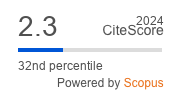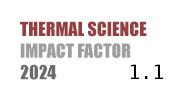ABSTRACT
This study involved the creation of a mathematical model and the research of the “reforming-fuel cell” system with the aim of obtaining optimal operating parameters for a solid oxide fuel cell. Based on the results of reforming system model¬ling in ASPEN PLUS simulation software, the exergy efficiency of the reformer was calculated. The results were used to determine the optimal parameters for the steam conversion process of hydrocarbon fuels. Also, in the ANSYS software package, the technical parameters of the fuel cell operation were calculated: the temperature of the fuel cell at the outlet of the anode, the current density at the outlet of the fuel cell, as well as the composition of the exhaust gases. As a result of the study, technological parameters were calculated, which allow us to draw a conclusion about the influence of gas composition on the output parameters of the fuel cell. For various molar compositions of synthesis gas, the efficiency of the fuel cell, the temperature at the anode outlet, and the current density were calculated. Based on the simulation data obtained, it can be concluded that the most optimal temperature range for the steam conversion reactor operation will be between 1125-1200 K under conditions without a catalyst. This same range corresponds to the highest exergetic efficiency which was calculated for this reactor and amounted to 67.3%. Additionally, based on various gas compositions within this range, the calculation of the current density was performed, reaching a maximum value of 5000 A/m². For the same range, the electric efficiency of the fuel cell was also calculated, with its maximum being 62.25%. According to the values of the exergetic efficiency of the reformer and the electrical efficiency of the fuel cell, the obtained calculations made it possible to conclude about the most optimal composition of the obtained synthesis gas.
KEYWORDS
PAPER SUBMITTED: 2024-12-10
PAPER REVISED: 2025-02-21
PAPER ACCEPTED: 2025-02-27
PUBLISHED ONLINE: 2025-04-05
THERMAL SCIENCE YEAR
2025, VOLUME
29, ISSUE
Issue 5, PAGES [3307 - 3318]
- Taner, T., The Novel and Innovative Design with Using H2 Fuel of PEM Fuel Cell: Efficiency of Thermodynamic Analyze, Fuel, 302 (2021), 121109
- Taner, Т., Energy and Exergy Analyze of PEM Fuel Cell: A Case Study of Modelling and Simulations, Energy, 143 (2018), Jan., pp. 284-294
- Taner, T., The Micro-Scale Modelling by Experimental Study in PEM Fuel Cell, Journal of Thermal Engineering, 3 (2017), 5, pp. 1515-1526
- Mandeep, S., et al., Solid Oxide Fuel Cell: Decade of Progress, Future Perspectives and Challenges, International Journal of Hydrogen Energy, 46 (2021), 54, pp. 27643-27674
- Beloev, I., et al., Utilization of Hydrogen-Containing Gas Waste from Deep Oil Refining at a Hybrid Power Plant with a Solid Oxide, Fuel Cells, 60 (2014), 1, 5
- Qidong, X., et al., A Comprehensive Review of Solid Oxide Fuel Cells Operating on Various Promising Alternative Fuels, Journal Energy Conversion and Management, 253 (2022), 115175
- Iliev, I. K., et al., Numerical Simulation of Processes in an Electrochemical Cell Using Comsol Multiphysics, Energies, 16 (2023), 21, 7265
- Taner, T., et al., Techno-Economic Analysis of a More Efficient Hydrogen Generation System Prototype: A Case Study of PEM Electrolyzer with Cr-C Coated SS304 Bipolar Plates, Fuel Cells, 19 (2019), 1, pp. 19-26
- Naqvi, S. A. H., et al., Hydrogen Production through Alkaline Electrolyzers: A Techno-Economic and Enviro-Economic Analysis, Chem. Eng. Technol., 46 (2013), 3, pp. 474-481
- Fang, Q., et al., Electrochemical Performance and Degradation Analysis of an SOFC Short Stack Following Operation of More than 100000 Hours, Electrochem., 166 (2019), 16, pp. F1320-F1325
- Ib, D., Tubular Reforming and Autothermal Reforming of Natural Gas - An Overview of Available Processes, Fuel Processing Technology, 4 (1995), 2-3, pp. 85-107
- Jingxuan, P., Dongqi, Z., Comprehensive Analysis of Solid Oxide Fuel Cell Performance Degradation Mechanism, Prediction, and Optimization Studies, Energies, 16 (2023), 2, 788
- Mosbaek Rasmus, R., Solid Oxide Fuel Cell Stack Diagnostics, Department of Energy Conversion and Storage, Technical University of Denmark, Lyngby, Denmark, 2014
- Astrom, K., et al., Reliability Analysis and Initial Requirements for FC Systems and Stacks, Power Sources, 171 (2007), 1, pp. 46-54
- Mozdzierz, M., et al., An Afterburner-Powered Methane/Steam Reformer for a Solid Oxide Fuel Cell Application, Heat and Mass Transfer, 54 (2018), Apr., pp. 2331-2341
- Mozdzierz, M., et al., Numerical Analysis of Helium-Heated Methane/Steam Reformer, Phys., Conf Ser., 745 (2016), 032, 081
- Yin, H., et al., Modelling of the Helium-Heated Steam Reformer for HTR-10, Nuclear Science and Technology, 44 (2007), 7, pp. 977-984
- Klein, J. M., et al., Modelling of a SOFC fuelled By Methane: From Direct Internal Reforming to Gradual Internal Reforming, Chem. Eng. Sci., 62 (2007), 6, pp. 1636-1649
- Sciazko, A., et al., A Novel Approach to Improve the Mathematical Modelling of the Internal Reforming Process for Solid Oxide Fuel Cells Using the Orthogonal Least Squares Method, Int. Journal Hydrog. Energy, 39 (2014), 29, pp. 16372-16389
- Iwai, H., et al., Numerical Simulation of Intermediate-Temperature Direct-Internal-Reforming Planar Solid Oxide Fuel Cell, Energy, 36 (2011), 4, pp. 2225-2234
- Nishino, T., et al., Comprehensive Numerical Modelling and Analysis of a Cell-Based Indirect Internal Reforming Tubular SOFC, Fuel Cell Science and Technology, 3 (2006), 1, pp. 33-44
- Nishino, T., Szmyd, J., Numerical Analysis of a Cell-Based Indirect Internal Reforming Tubular SOFC Operating with Biogas, Fuel Cell Science and Technology, 7 (2010), 5, 051004
- Brus, G., et al., Experimental and Numerical Analysis of Transport Phenomena in an Internal Indirect Fuel Reforming Type Solid Oxide Fuel Cells Using Ni/SDC as a Catalyst, Phys. Conf. Ser., 395 (2012), 012159
- Sciazko, A., et al., A Novel Approach to The Experimental Study on Methane/Steam Reforming Kinetics Using the Orthogonal Least Squares Method, Power Sources, 262 (2014), pp. 245-254

